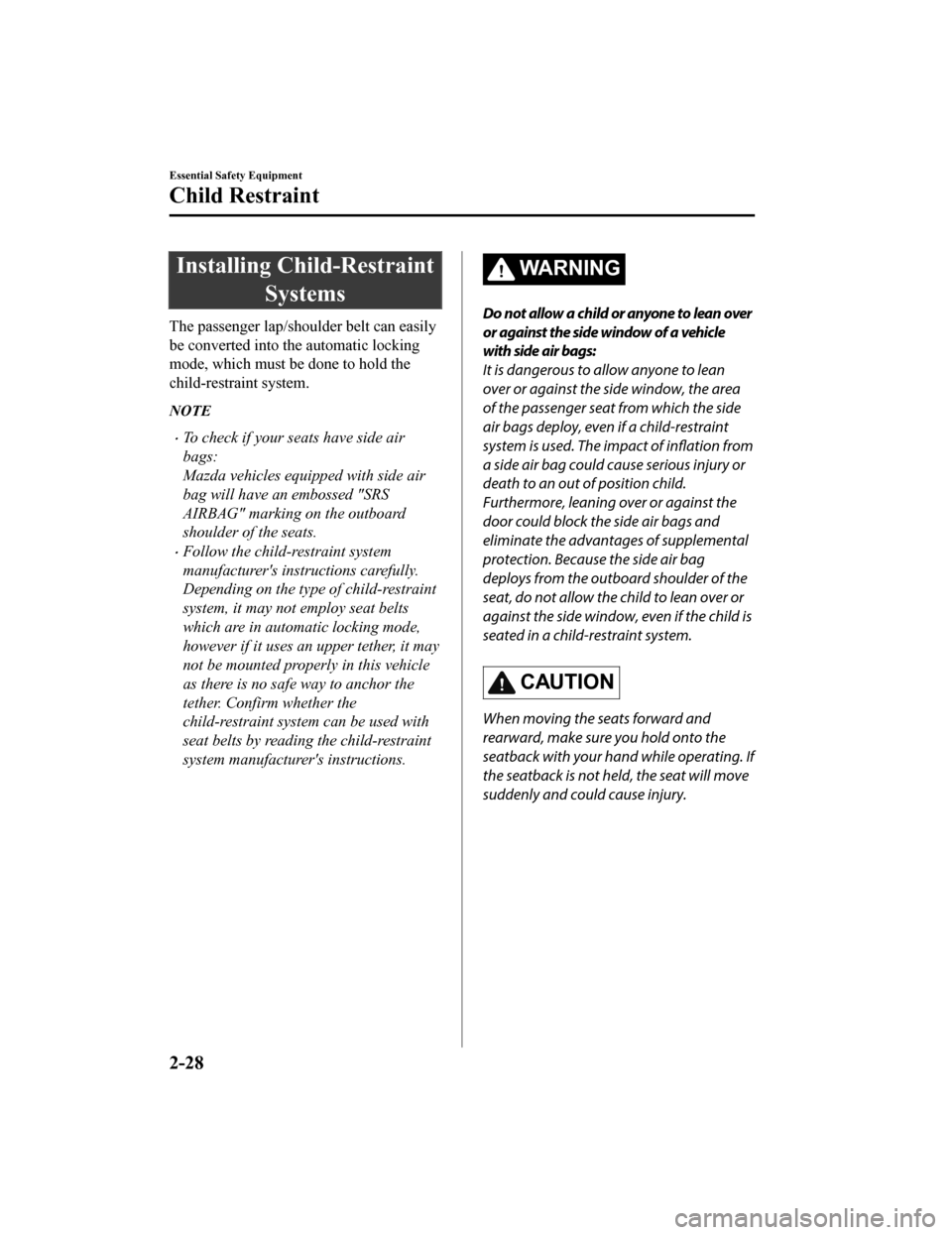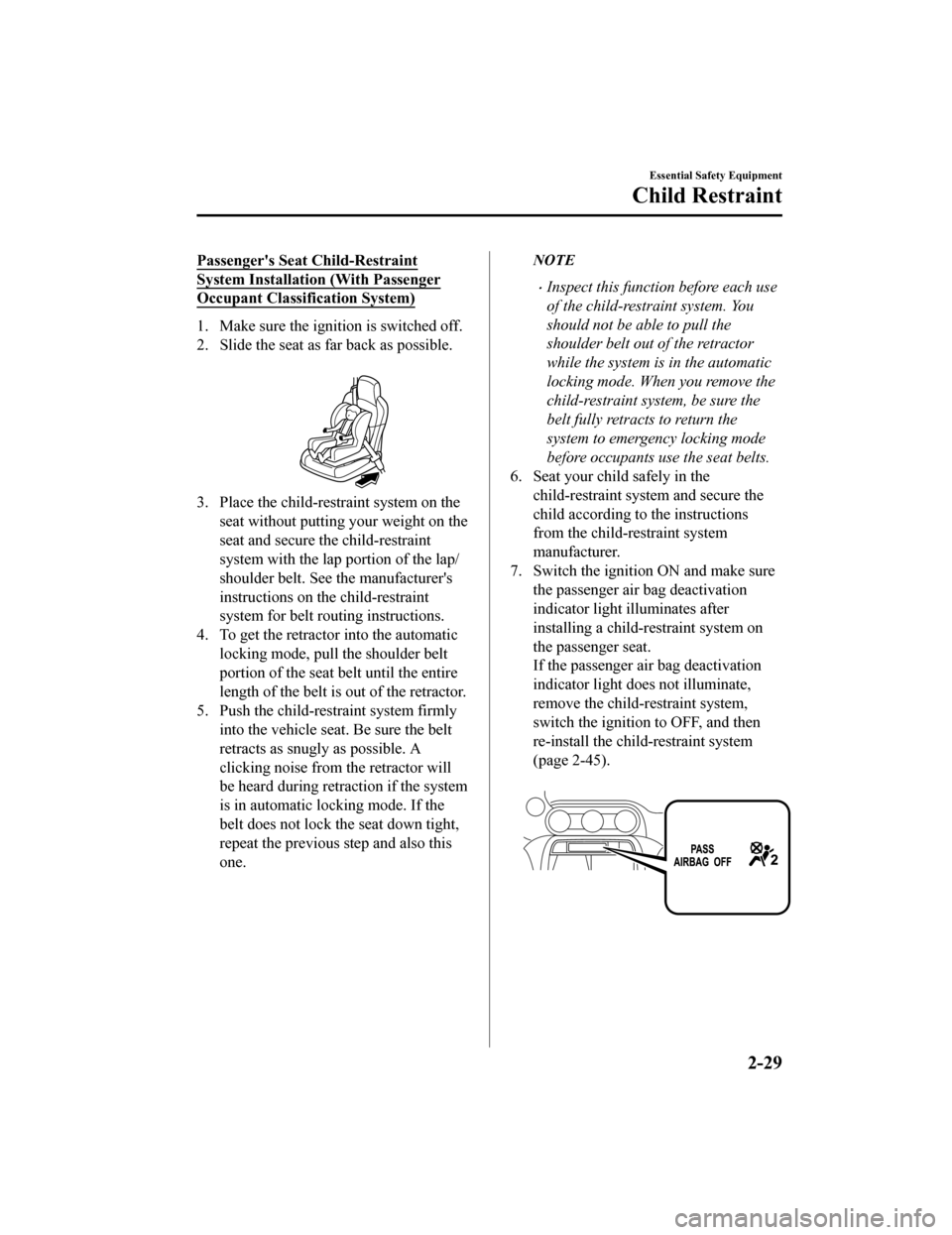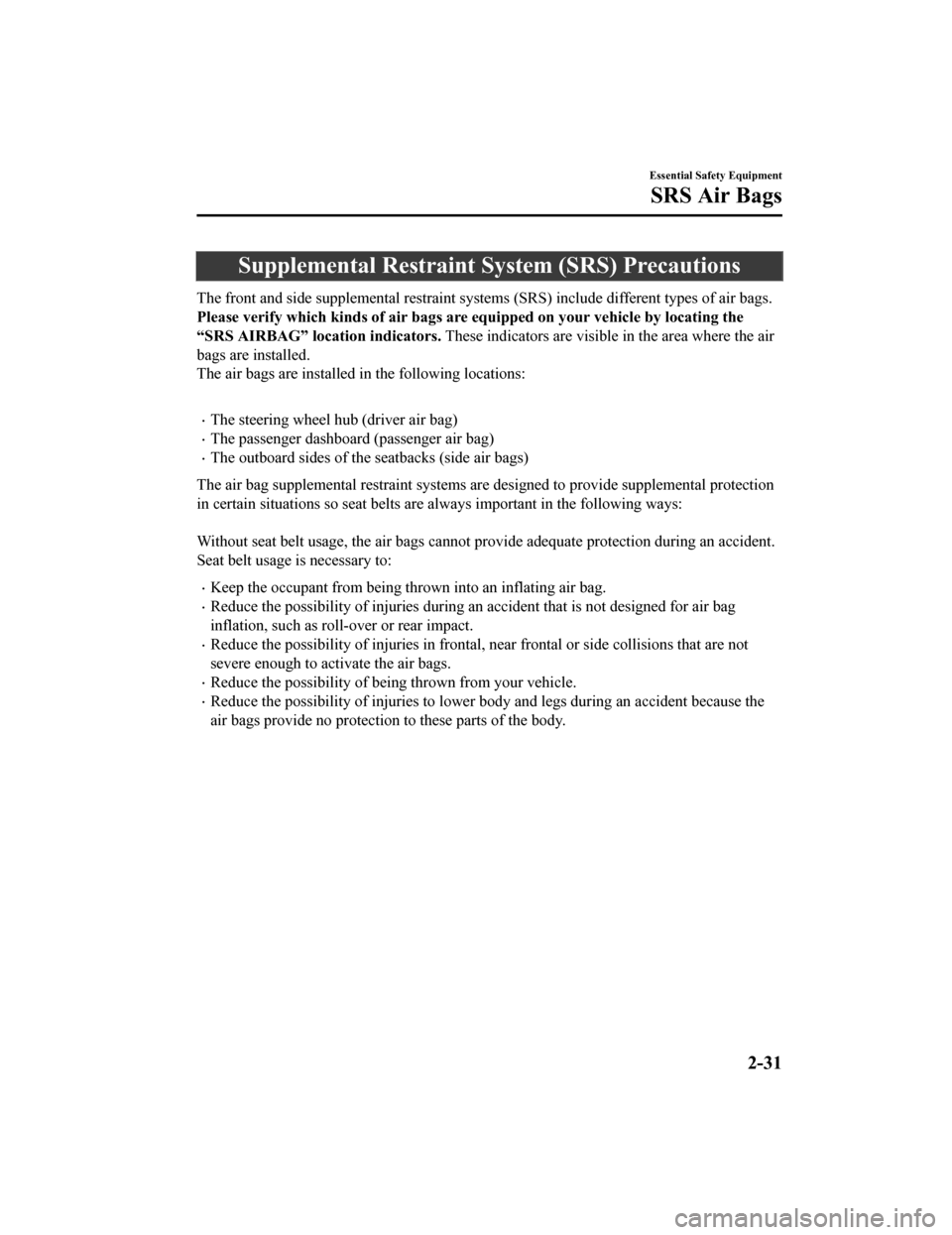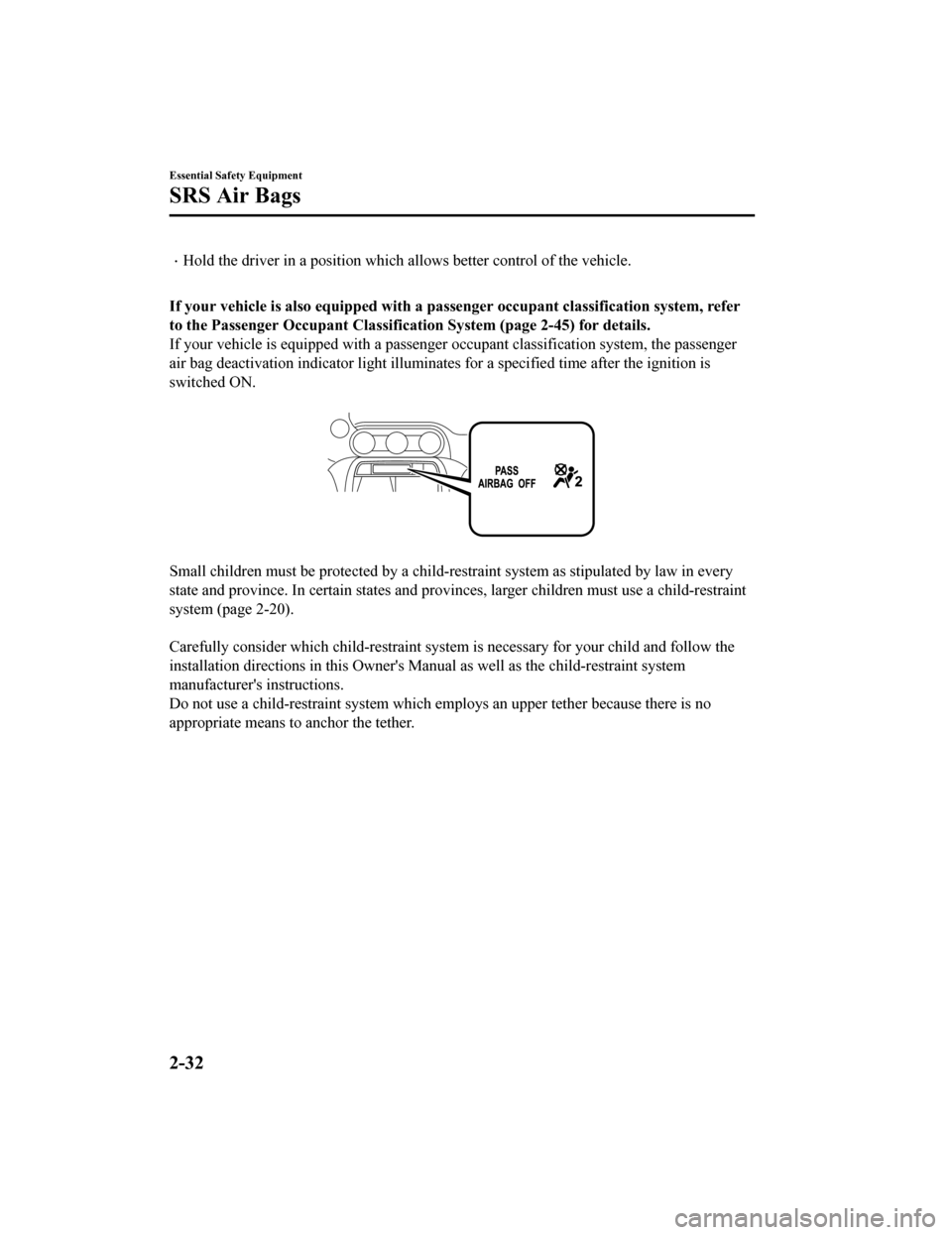MAZDA MODEL MX-5 2019 (in English) Service Manual
Manufacturer: MAZDA, Model Year: 2019, Model line: MODEL MX-5, Model: MAZDA MODEL MX-5 2019Pages: 553, PDF Size: 59.03 MB
Page 41 of 553

Seating positionPassenger
Non i-size compatible with a support leg (Yes/No) No
Lower ISOFIX anchorages but without Top Tether
(Yes/No) No
U = Suitable for “universal” cate
gory restraints approved for use in this mass group.
UF = Suitable for forward-facing “universal” category restraints approved for use in this mass group.
IUF = Suitable for ISOFIX forward child restraints systems of u niversal category approved for use in the mass
group.
L = Suitable for partic ular child restraints given on attached list. These restraints may be of the “specific vehicle”,
“restricted” or “semi-universal” categories.
IL = Suitable for particular ISO FIX child restraint systems (CRS) given in the attached list. These ISOFIX CRS are
those of the “specific vehicle”, “restricted” or “semi-universal” categories.
i-U = Suitable for i-Size “unive rsal” Child Restraint Systems forward and rearward facing.
i-UF = Suitable for forward-faci ng i-Size “universal” Child Restraint Systems only.
Yes = Child-restraint system can be secured on the seat.
No = Child-restraint system canno t be secured on the seat, or there is no fixture.
X = Child-restraint syste m cannot be installed.
A Mazda genuine child-restraint s ystem can be installed in the forward-facing position. Regarding child-restraint
systems which can be installed, refer to the accessories catalo g.
(Except Mexico)
Regarding child-restraint systems which can be installed to your Mazda, consult an
Authorized Mazda Dealer.
Please comply with the legal regulations concerning the use of child-restraint systems in
your country.
For the CRS which do not carry t he ISO/XX size class identification (A to G), for the
applicable mass group, the child seat manufacturer shall indica te the vehicle specific
LATCH child-restraint systems recommended for each position.
Essential Safety Equipment
Child Restraint
2-27
MX-5_8GV5-EA-18E_Edition3 2018-7-17 15:48:16
Page 42 of 553

Installing Child-RestraintSystems
The passenger lap/shoulder belt can easily
be converted into the automatic locking
mode, which must be done to hold the
child-restraint system.
NOTE
To check if your seats have side air
bags:
Mazda vehicles equipped with side air
bag will have an embossed "SRS
AIRBAG" marking on the outboard
shoulder of the seats.
Follow the child- restraint system
manufacturer's instructions carefully.
Depending on the type of child-restraint
system, it may not employ seat belts
which are in automatic locking mode,
however if it uses an upper tether, it may
not be mounted properly in this vehicle
as there is no safe way to anchor the
tether. Confirm whether the
child-restraint system can be used with
seat belts by reading the child-restraint
system manufacturer's instructions.
WA R N I N G
Do not allow a child or anyone to lean over
or against the side window of a vehicle
with side air bags:
It is dangerous to allow anyone to lean
over or against the side window, the area
of the passenger seat from which the side
air bags deploy, even if a child-restraint
system is used. The impact of inflation from
a side air bag could cause serious injury or
death to an out of position child.
Furthermore, leaning over or against the
door could block the side air bags and
eliminate the advantages of supplemental
protection. Because the side air bag
deploys from the outboard shoulder of the
seat, do not allow the child to lean over or
against the side window, even if the child is
seated in a child-restraint system.
CAUTION
When moving the seats forward and
rearward, make sure you hold onto the
seatback with your hand while operating. If
the seatback is not held, the seat will move
suddenly and could cause injury.
Essential Safety Equipment
Child Restraint
2-28
MX-5_8GV5-EA-18E_Edition3 2018-7-17 15:48:16
Page 43 of 553

Passenger's Seat Child-Restraint
System Installation (With Passenger
Occupant Classification System)
1. Make sure the ignition is switched off.
2. Slide the seat as far back as possible.
3. Place the child-restraint system on theseat without putti ng your weight on the
seat and secure the child-restraint
system with the lap portion of the lap/
shoulder belt. See the manufacturer's
instructions on the child-restraint
system for belt routing instructions.
4. To get the retractor into the automatic locking mode, pull the shoulder belt
portion of the seat belt until the entire
length of the belt is out of the retractor.
5. Push the child-restraint system firmly
into the vehicle seat. Be sure the belt
retracts as snugly as possible. A
clicking noise from the retractor will
be heard during retraction if the system
is in automatic locking mode. If the
belt does not lock the seat down tight,
repeat the previous step and also this
one.
NOTE
Inspect this function before each use
of the child-restraint system. You
should not be able to pull the
shoulder belt out of the retractor
while the system is in the automatic
locking mode. When you remove the
child-restraint system, be sure the
belt fully retracts to return the
system to emergency locking mode
before occupants use the seat belts.
6. Seat your child safely in the child-restraint system and secure the
child according to the instructions
from the child-restraint system
manufacturer.
7. Switch the ignition ON and make sure the passenger air bag deactivation
indicator light illuminates after
installing a child-restraint system on
the passenger seat.
If the passenger air bag deactivation
indicator light does not illuminate,
remove the child-restraint system,
switch the ignition to OFF, and then
re-install the child-restraint system
(page 2-45).
Essential Safety Equipment
Child Restraint
2-29
MX-5_8GV5-EA-18E_Edition3 2018-7-17 15:48:16
Page 44 of 553

WA R N I N G
Do not seat a child in a child-restraint
system on the passenger seat if the
passenger air bag deactivation indicator
light does not illuminate (With Passenger
Occupant Classification System):
Seating a child in a child-restraint system
installed on the passenger seat with the
passenger air bag deactivation indicator
light not illuminated is dangerous. If this
indicator light does not illuminate, this
means that the passenger front and side air
bags, and seat belt pretensioner are ready
for deployment. If an accident were to
deploy an air bag, a child in a
child-restraint system sitting in the
passenger seat could be seriously injured or
killed. If the indicator light does not
illuminate after seating a child in a
child-restraint system on the passenger
seat consult an Authorized Mazda Dealer
as soon as possible.
Essential Safety Equipment
Child Restraint
2-30
MX-5_8GV5-EA-18E_Edition3 2018-7-17 15:48:16
Page 45 of 553

Supplemental Restraint System (SRS) Precautions
The front and side supplemental restraint systems (SRS) include different types of air bags.
Please verify which kinds of air bags are equipped on your vehicle by locating the
“SRS AIRBAG” location indicators. These indicators are visible in the area where the air
bags are installed.
The air bags are installed i n the following locations:
The steering wheel hub (driver air bag)
The passenger dashboard (passenger air bag)
The outboard sides of the seatbacks (side air bags)
The air bag supplemental restraint systems are designed to prov ide supplemental protection
in certain situations so seat belts are always important in the following ways:
Without seat belt usage, the air bags cannot provide adequate p rotection during an accident.
Seat belt usage is necessary to:
Keep the occupant from being thrown into an inflating air bag.
Reduce the possibility of injuri es during an accident that is not designed for air bag
inflation, such as roll-over or rear impact.
Reduce the possibility of inju ries in frontal, near frontal or side collisions that are not
severe enough to activate the air bags.
Reduce the possibility of being thrown from your vehicle.
Reduce the possibility of injuries to lower body and legs durin g an accident because the
air bags provide no protection to these parts of the body.
Essential Safety Equipment
SRS Air Bags
2-31
MX-5_8GV5-EA-18E_Edition3 2018-7-17 15:48:16
Page 46 of 553

Hold the driver in a position which allows better control of the vehicle.
If your vehicle is also equipped with a passenger occupant classification system, refer
to the Passenger Occupant Class ification System (page 2-45) for details.
If your vehicle is equipped with a passenger occupant classific ation system, the passenger
air bag deactivation indicator light illuminates for a specifie d time after the ignition is
switched ON.
Small children must be protected by a child-restraint system as stipulated by law in every
state and province. In certain states and provinces, larger chi ldren must use a child-restraint
system (page 2-20).
Carefully consider whic h child-restraint system is necessary fo r your child and follow the
installation directions in this Owner's Manual as well as the c hild-restraint system
manufacturer's instructions.
Do not use a child-restraint system which employs an upper teth er because there is no
appropriate means to anchor the tether.
Essential Safety Equipment
SRS Air Bags
2-32
MX-5_8GV5-EA-18E_Edition3 2018-7-17 15:48:16
Page 47 of 553

WA R N I N G
Seat belts must be worn in air bag equipped vehicles:
Depending only on the air bags for protection during an accident is dangerous. Alone, air
bags may not prevent serious injuries. The appropriate air bags can be expected to inflate
only in the first accident, such as frontal, near frontal or side collisions that are at least
moderate. Vehicle occupants shou ld always wear seat belts.
Always make sure the passenger air bag deactivation indicator light is illuminated when
using a child-restraint system (With Passenger Occupant Classification System):
Seating a child in a child-restraint system that is installed on the passenger seat with the
passenger air bag deactivation indicator light not illuminated is extremely dangerous. In an
accident, an air bag could inflate and cause seri ous injuries or even death to the child seated
in the child-restraint system. Always make su re the passenger air bag deactivation indicator
light is illuminated.
Refer to Occupant Classification System on page 2-45.
Do not sit too close to the driver and passenger air bags:
Sitting too close to the driver and passenger air bag modules or placing hands or feet on them
is extremely dangerous. The driver and passenger air bags inflate with great force and speed.
Serious injuries could occur if someone is too close. The driver should always hold onto only
the rim of the steering wheel. The passenger should keep both feet on the floor. Seat
occupants should adjust their seats as far back as possible and always sit upright against the
seatbacks with seat belts worn properly.
Do not sit too close to a door or lean against doors in vehicles with side air bags:
Sitting too close to the side air bag module s or placing hands on them is extremely
dangerous. A side air bag inflates with grea t force and speed directly out of the outboard
shoulder of the seat and expands along the door on the side the car is hit. Serious injury could
occur if someone is sitting too close to the do or or leaning against a window in the seats.
Furthermore, sleeping up against the door or hanging out the driver-side window while
driving could block the side air bag and eliminate the advantages of supplemental
protection. Give the side air bags room to work by sitting in the center of the seat while the
vehicle is moving with seat belts worn properly.
Essential Safety Equipment
SRS Air Bags
2-33
MX-5_8GV5-EA-18E_Edition3 2018-7-17 15:48:16
Page 48 of 553

Sit in the center of the seat and wear seat belts properly:
Sitting too close to the side air bag modules or placing hands on them, or sleeping up against
the door or hanging out the windows is extrem ely dangerous. The side air bags inflate with
great force and speed directly expanding along th e door on the side the car is hit. Serious
injury could occur if someone is sitting too clos e to the door. Give the side air bags room to
work by sitting in the center of the seat while the vehicle is moving with seat belts worn
properly.
Do not attach objects on or around the area where driver and passenger air bags deploy:
Attaching an object to the driver and passenger air bag modules or placing something in
front of them is dangerous. In an accident, an object could interfere with air bag inflation and
injure the occupants.
Do not attach objects on or around the area where a side air bag deploys:
Attaching objects to the seat in such a way as to cover the outboard side of the seat in any
way is dangerous. In an accident the object could interfere with the side air bag, which
inflates from the outboard side of the seats, impe ding the added protection of the side air bag
system or redirecting the air bag in a way that is dangerous. Furthermore, the bag could be
cut open releasing the gas.
Do not hang net bags, map pouches or backpacks with side straps on the seats. Never use
seat covers on the seats. Always keep the side air bag modules in your seats free to deploy in
the event of a side collision.
Do not touch the components of the supplemental restraint system after the air bags have
inflated:
Touching the components of the supplemental restraint system after the air bags have
inflated is dangerous. Immediately after
inflation, they are very hot. You could get burned.
Never install any front-end equipment to your vehicle:
Installation of front-end equipment, such as frontal protection bar (kangaroo bar, bull bar,
push bar, or other similar devices), snowplow , or winches, is dangerous. The air bag crash
sensor system could be affected. This could cause air bags to inflate unexpectedly, or it could
prevent the air bags from inflating during an accident. Occupants could be seriously injured.
Do not modify the suspension:
Modifying the vehicle suspension is dangerous. If the vehicle's height or the suspension is
modified, the vehicle will be unable to accura tely detect a collision resulting in incorrect or
unexpected air bag deployment and the possibility of serious injuries.
Essential Safety Equipment
SRS Air Bags
2-34
MX-5_8GV5-EA-18E_Edition3 2018-7-17 15:48:16
Page 49 of 553

Do not modify a door or leave any damage unrepaired. Always have an Authorized Mazda
Dealer inspect a damaged door:
Modifying a door or leaving any damage unrepaired is dangerous. Each door has a side crash
sensor as a component of the supplemental restr aint system. If holes are drilled in a door, a
door speaker is left removed, or a damaged d oor is left unrepaired, the sensor could be
adversely affected causing it to not detect the pressure of an impact correctly during a side
collision. If a sensor does not detect a side impa ct correctly, the side air bags and the seat belt
pretensioner may not operate normally which could result in serious injury to occupants.
Do not modify the supplemental restraint system:
Modifying the components or wiri ng of the supplemental restraint system is dangerous. You
could accidentally activate it or make it inoperable. Do not make any modifications to the
supplemental restraint system. This includes inst alling trim, badges, or anything else over the
air bag modules. It also includes installing extra electrical equipment on or near system
components or wiring. An Authorized Mazda Dealer can provide the special care needed in
the removal and installation of seats. It is important to protect the air bag wiring and
connections to assure that the bags do not accidentally deploy, and that the passenger
occupant classification system and the seats retain an undamaged air bag connection.
Do not place luggage or other objects under the seats:
Placing luggage or other objects under the seats is dangerous. The components essential to
the supplemental restraint system could be damaged, and in the event of a side collision, the
appropriate air bags may not deploy, which could result in death or serious injury. To prevent
damage to the components essential to the supplemental restraint system, do not place
luggage or other objects under the seats.
Do not operate a vehicle with damaged air bag/seat belt pretensioner system components:
Expended or damaged air bag/seat belt preten sioner system components must be replaced
after any collision which caused them to deploy or damage them. Only a trained Authorized
Mazda Dealer can fully evaluate these systems to see that they will work in any subsequent
accident. Driving with an expended or damage d air bag or pretensioner unit will not afford
you the necessary protection in the event of any subsequent accident which could result in
serious injury or death.
Do not remove interior air bag parts:
Removing any components such as the seats, front dashboard, the steering wheel, containing
air bag parts or sensors is dangerous. These pa rts contain essential air bag components. The
air bag could accidentally activate and cause serious injuries. Always have an Authorized
Mazda Dealer remove these parts.
Essential Safety Equipment
SRS Air Bags
2-35
MX-5_8GV5-EA-18E_Edition3 2018-7-17 15:48:16
Page 50 of 553

Properly dispose of the air bag system:
Improper disposal of an air bag or a vehicle with live air bags in it can be extremely
dangerous. Unless all safety procedures are foll owed, injury could result. Have an Authorized
Mazda Dealer safely dispose of the air bag sy stem or scrap an air bag equipped vehicle.
NOTE
If it becomes necessary to have the components or wiring system for the supplementary
restraint system modified to accommodate a person with certain medical conditions in
accordance with a certified physician, contact an Authorized Mazda Dealer, refer to
“Customer Assistance (U.S.A.)” (page 8-2).
When an air bag deploys, a loud inflation noise can be heard and some smoke will be
released. Neither is likely to cause injury, however, the text ure of the air bags may cause
light skin injuries on body parts not covered with clothing through friction.
Should you sell your Mazda, we urge you to tell the new owner of its air bag systems and
that familiarization with all instructions about them, from the Owner's Manual, is
important.
Vehicles with a passenger air bag have a warning label attached as shown in the
following.
(Except Mexico)
This warning label is displayed in compliance with regulations.
(Mexico)
This warning label reminds you not to put a rear-facing child-restraint system on the
passenger seat at any time.
Essential Safety Equipment
SRS Air Bags
2-36
MX-5_8GV5-EA-18E_Edition3 2018-7-17 15:48:16